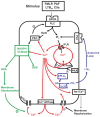Pharmacological control of neutrophil-mediated inflammation: strategies targeting calcium handling by activated polymorphonuclear leukocytes
- PMID: 19920897
- PMCID: PMC2761182
Pharmacological control of neutrophil-mediated inflammation: strategies targeting calcium handling by activated polymorphonuclear leukocytes
Abstract
Unlike most other effector cells of the innate, as well as the adaptive immune systems, the neutrophil is a relatively undiscerning aggressor with scant regard for damage limitation. Although this highly combative, professional phagocyte has become increasingly implicated in the immunopathogenesis of many acute and chronic inflammatory disorders, of both infective and noninfective origin, effective pharmacological strategies to counter neutrophil aggression have remained elusive. Activation of neutrophils results in rapid mobilization of both stored and extracellular Ca(2+), resulting in abrupt, usually transient increases in cytosolic Ca(2+), which precede, and are a prerequisite for activation of the Ca(2+)-dependent pro-inflammatory activities of these cells. Mobilization of Ca(2+) by, and restoration of Ca(2+) homeostasis to activated neutrophils are multistep processes which present a number of potential targets, some well recognized and others novel and unconventional, for the pharmacological control of neutrophil-mediated inflammation. Uncovering these targets represents the primary focus of this review.
Keywords: NADPH oxidase; calcium; cyclic AMP; neutrophils; sodium-calcium exchanger.
Figures


Similar articles
-
Taming the neutrophil: calcium clearance and influx mechanisms as novel targets for pharmacological control.Clin Exp Immunol. 2005 Aug;141(2):191-200. doi: 10.1111/j.1365-2249.2005.02800.x. Clin Exp Immunol. 2005. PMID: 15996182 Free PMC article. Review.
-
Accelerated resequestration of cytosolic calcium and suppression of the pro-inflammatory activities of human neutrophils by CGS 21680 in vitro.Br J Pharmacol. 2000 Jun;130(4):717-24. doi: 10.1038/sj.bjp.0703344. Br J Pharmacol. 2000. PMID: 10864876 Free PMC article.
-
Regulation of calcium homeostasis in activated human neutrophils--potential targets for anti-inflammatory therapeutic strategies.S Afr Med J. 2002 Dec;92(12):990-6. S Afr Med J. 2002. PMID: 12561417
-
Dissociation of the PAF-receptor from NADPH oxidase and adenylate cyclase in human neutrophils results in accelerated influx and delayed clearance of cytosolic calcium.Br J Pharmacol. 2002 May;136(1):81-9. doi: 10.1038/sj.bjp.0704685. Br J Pharmacol. 2002. PMID: 11976271 Free PMC article.
-
Calcium signaling and regulation of neutrophil functions: Still a long way to go.J Leukoc Biol. 2020 Feb;107(2):285-297. doi: 10.1002/JLB.3RU0719-241R. Epub 2019 Dec 16. J Leukoc Biol. 2020. PMID: 31841231 Review.
Cited by
-
Ion Channels and Transporters in Inflammation: Special Focus on TRP Channels and TRPC6.Cells. 2018 Jul 4;7(7):70. doi: 10.3390/cells7070070. Cells. 2018. PMID: 29973568 Free PMC article. Review.
-
Pharmacological approaches to regulate neutrophil activity.Semin Immunopathol. 2013 Jul;35(4):395-409. doi: 10.1007/s00281-013-0366-8. Epub 2013 Mar 15. Semin Immunopathol. 2013. PMID: 23494251 Review.
-
NADPH oxidase controls pulmonary neutrophil infiltration in the response to fungal cell walls by limiting LTB4.Blood. 2020 Mar 19;135(12):891-903. doi: 10.1182/blood.2019003525. Blood. 2020. PMID: 31951647 Free PMC article.
-
Cysteinyl leukotriene receptor-1 antagonists as modulators of innate immune cell function.J Immunol Res. 2014;2014:608930. doi: 10.1155/2014/608930. Epub 2014 May 25. J Immunol Res. 2014. PMID: 24971371 Free PMC article. Review.
-
Beta-adducin and sodium-calcium exchanger 1 gene variants are associated with systemic lupus erythematosus and lupus nephritis.Rheumatol Int. 2015 Dec;35(12):1975-83. doi: 10.1007/s00296-015-3298-x. Epub 2015 Jun 5. Rheumatol Int. 2015. PMID: 26045217
References
-
- Ali H, Sozzani S, Fisher I, et al. Differential regulation of formyl peptide and platelet-activating factor receptors: role of phospholipase Cβ, phosphorylation by protein kinase A. J Biol Chem. 1998;273:11012–16. - PubMed
-
- Anderson R, Steel HC, Tintinger GR. Inositol 1,4,5-triphosphate-mediated shuttling between intracellular stores and the cytosol contributes to the sustained elevation in cytosolic calcium in FMLP-activated human neutrophils. Biochem Pharmacol. 2005;69:1567–75. - PubMed
-
- Arm JP. Leukotriene generation and clinical implications. Allergy Asthma Proc. 2004;25:37–42. - PubMed
LinkOut - more resources
Full Text Sources
Miscellaneous

